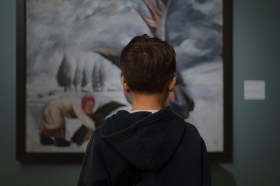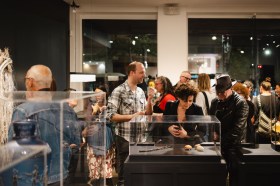This is a report that has been long in landing. And hopefully, one that is not diffused in its intention, given its lengthy 300-page delivery, and further round of submissions.
We are talking about The Productivity Commission’s Aboriginal and Torres Strait Islander Visual Arts and Crafts Draft Report, tabled in recent weeks (19 July), which is only now getting feedback from agencies such as Arts Law Australia and NAVA (National Association for the Visual Arts).
It came about as a key recommendation of the House of Representatives Report on the impact of inauthentic art and craft in the style of First Nations peoples, tabled in 2018, suggesting that the Productivity Commission conduct a comprehensive inquiry into the value and structure of the current markets for First Nations art and crafts.
The Government ‘signed off’ on the inquiry in Parliament in September 2020.
So what does this new report survey, and does it offer a framework for protection?
Two in three Indigenous-style souvenirs are inauthentic, with no connection to Aboriginal and Torres Strait Islander people.
Productivity Commission, 2022
Key outcome
The Commission is calling for mandatory labelling of inauthentic products to warn consumers, a strengthened code of conduct, and protections for Aboriginal and Torres Strait Islander cultural expressions.
Productivity Commissioner Romlie Mokak said: ‘Inauthentic products can mislead consumers, deprive Aboriginal and Torres Strait Islander artists of income and disrespect culture.’
He added: ‘Mandatory labelling would steer consumers toward authentic products and put the compliance burden on those producing fake products, not Aboriginal and Torres Strait Islander artists.
Read: Protecting Aboriginal and Torres Strait Islander visual arts and crafts
‘On balance, we consider it is a more practical response than trying to ban inauthentic products,’ said Mokak.
But sector says the recommendation does not go far enough.
JUMP TO:
Report’s key recommendations
Sector feedback
Understanding changes to legislation
Key findings of Commission
Total sales of Aboriginal and Torres Strait Islander visual arts and crafts reached about $250 million in 2019–20; this includes at least $83 million in sales of merchandise and consumer products (mostly souvenirs) bearing Aboriginal and Torres Strait Islander art and designs.
They estimate that in 2019–20 alone, spending on inauthentic Indigenous-style souvenir products totalled $41–54 million, accounting for 55–61% of spending on Aboriginal and Torres Strait Islander souvenirs.
Further, over 80% of stock images depicting Aboriginal and Torres Strait Islander designs, styles and motifs are inauthentic, made by overseas creators without evidence of any licensing agreement with an Aboriginal and Torres Strait Islander person.
Approximately only one in six of the sampled stock images originated in Australia.
The Commission also analysed a random sample of listings from one of the largest and most prominent online print-on-demand merchandise marketplaces. About 60% of sampled listings appearing under the search terms ‘Aboriginal art’, ‘Australian Aboriginal Art’, ‘Australia Aboriginal Art’, ‘Australian Indigenous Art’ and ‘Australia Indigenous Art’ were likely inauthentic.
The Commission also agreed that legal recognition and protection of ICIP (Indigenous Cultural and Intellectual Property) is patchy, with very few limits on whether, how and by whom ICIP is used in visual arts and crafts.
They added that capacity in the sector is under strain; some art centres are struggling to fulfil their cultural and social roles…(and) workforce and skills issues persist.
Sideline but integral to their findings, they also determined that the current approach to funding objectives in the sector is not characterised by shared decision-making between governments and Aboriginal and Torres Strait Islander people under the National Agreement on Closing the Gap.
Key recommendations of draft report
The report states: ‘Inauthentic arts and crafts are a pervasive and longstanding problem. They disrespect and misrepresent culture and, by misleading consumers and denting confidence in the market, they deprive Aboriginal and Torres Strait Islander artists of income.’
Its key recommendations are:
- A mandatory labelling scheme for inauthentic products should be developed by the Australian Government
- New cultural rights legislation should be introduced to recognise and protect cultural assets in relation to visual arts and crafts. This would be a new law that would allow for legal action
- An ICIP Strategy is needed to coordinate regulatory measures
- The Australian Government should commission an independent evaluation of the effectiveness of Australian Government expenditure directed to the Aboriginal and Torres Strait Islander visual arts and crafts sector. The scope of the review should include the Indigenous Visual Arts Industry Support (IVAIS) program, the National Indigenous Visual Arts (NIVA) Action Plan and relevant Australia Council programs. This should be completed by December 2025
- The Australian Government, in partnership with state and territory governments, should modestly increase funding to Indigenous Art Code Limited to support key priorities
- The Australian Government should ensure that legal support services for artists are accessible.
To read the Draft Report overview
Sector feedback on draft report
Arts Law Australia has championed the need for industry protection from day one, when it co-launched the Fake Art Harms Campaign in 2016 at that year’s Darwin Festival. Almost six years to the day, we are still caught in the feedback stage.
A key advocate in the Fake Art Harms Culture Standing Committee, along with Copyright Agency and the Indigenous Art Code, Arts Law said in a statement (1 August), that they are ‘pleased that the Commission has agreed with the concerns’ raised by the 2016 campaign.
But continued, ‘Labelling of “fake art” is not enough of a response. We are disappointed that the Commission has not supported our recommendation to change the Australian Consumer Law to ban inauthentic Indigenous art and products altogether.’
It was a view shared by in a statement, Penelope Benton for NAVA: ‘Disappointingly the report recommends mandatory labelling of inauthentic products rather than a flat out ban.’
Arts Law added: ‘The Commission has prioritised businesses and consumers by allowing these products to remain and instead recommending mandatory labelling of inauthentic products.’
They make the point: ‘Given the Australian Government’s commitment to ‘Closing the Gap’ and the ‘Indigenous Advancement Strategy’, why would we want to continue to allow inauthentic product in the market at all?
‘The newly elected Labor Government said that they are committed to strengthening economic and job opportunities for First Nations people. We would like to see this election promise honoured by the Government making enacting legislation to ban “fake art” to give a real opportunity for the enrichment of the social, economic and cultural lives of Aboriginal and Torres Strait Islander people and communities,’ said Arts Law.
More on what tightening legislation means
The Commission has acknowledged that current intellectual property laws do not do enough to recognise and protect ICIP, and have agreed that standalone legislation must be introduced.
‘Our draft report proposes new legislation that would recognise the rights of Aboriginal and Torres Strait Islander people to protect these cultural expressions,’ Commissioner Lisa Gropp said. ‘(Currently) Communities have limited legal avenues to protect their sacred stories and symbols from being used without permission and out of context.’
As proposed, ICIP laws would only allow for legal action where protected cultural assets are used in visual arts and crafts without the authorisation of traditional owners.
Arts Law added: ‘While the Commission’s scope was limited to the visual arts and craft market, we recognise that ICIP needs protection across other art form areas and products available to consumers and will be advocating for this to be considered with the introduction of standalone ICIP legislation.’
The report says that such legislation would give traditional owners the right to:
- control their cultural assets
- choose whether to authorise the use of their cultural assets
- place conditions on the use of their cultural assets (including payment)
- protect their cultural assets from misappropriation, including by taking legal action.
‘These rights would also be inalienable, meaning that they can only belong to traditional owners and cannot be sold or transferred to another party,’ they clarified.
The Productivity Commission is welcoming responses to their draft report with a submission deadline by Monday 29 August 2022.
The final report is expected to be handed to the Australian Government in November 2022.
The Productivity Commission is an independent advisory body that conducts research and makes recommendations to government to develop policy and legislation.





